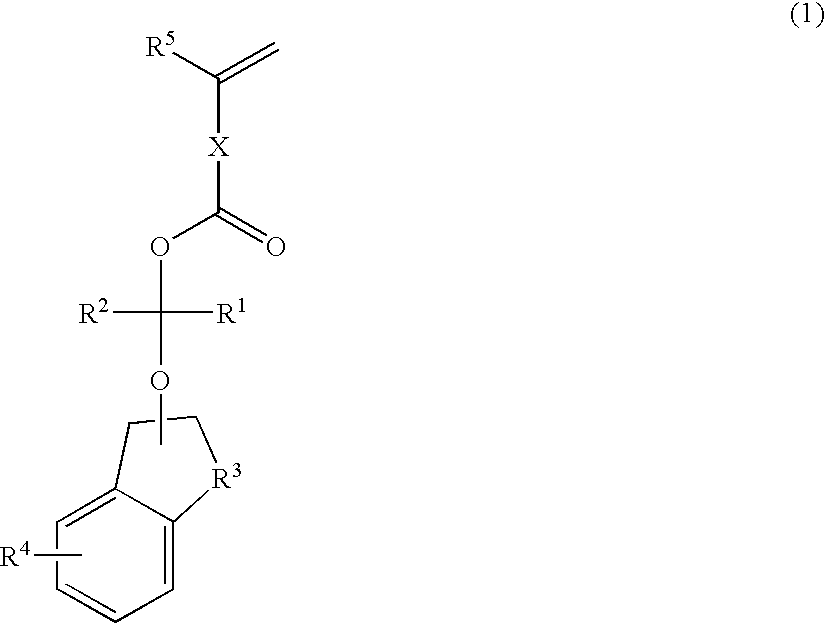Polymerizable compound, polymer, positive resist composition, and patterning process using the same
a technology of polymerizable compounds and compositions, applied in the direction of basic electric elements, electrical equipment, nuclear engineering, etc., can solve the problems of affecting the etching resistance of the mask, the effect of the mask size misalignment on the size change of the pattern on the wafer becomes a problem, and the tendency to a lower sensitivity of the resist becomes a problem, etc., to achieve excellent etching resistance, improve the pattern configuration, and improve the etching resistance resistance a technology of polymerizable compound and polymerization process, polymerizable compound and polymerization process, polymerizable compound and polymerization process, polymerizable compound and polymerization process, applied in the field of polymerizable compound and polymerization process, which is applied in the field of polymerizable effect of polymerization process, and the effect of the same, and achieve the effect of sensitivity and resolution, improve the effect of the sensitivity of the a technology of polymerizable compound and polymerization technology, applied in the field of polymerizable compound and polymerization technology, applied in the same technology of polymer
- Summary
- Abstract
- Description
- Claims
- Application Information
AI Technical Summary
Benefits of technology
Problems solved by technology
Method used
Image
Examples
synthetic example 1
[0249]Into a 2-liter flask were charged 7.0 g of Monomer 1, 4.7 g of 3-hydroxy-1-adamantyl methacrylate, 11.2 g of 3-oxo-2,7-dioxatricyclo[4.2.1.04,8]nonane-9-yl methacrylate, and 40 g of tetrahydrofurane as a solvent. The flask was cooled to −70° C. under a nitrogen atmosphere, and the procedure of a deaeration under vacuum followed by a nitrogen blow was repeated three times. After heated to a room temperature, 1.2 g of AIBN (azobisisobutyronitrile) was added as a polymerization initiator, and after the temperature was raised to 60° C., the reaction was carried out for 15 hours. The reaction solution was poured into 1 liter of isopropyl alcohol for precipitation, and the white solid obtained was filtered out and dried at 60° C. under a reduced pressure to obtain a white polymer.
[0250]A 13C-NMR, a 1H-NMR, and a GPC of the polymer thus obtained were measured to obtain the following analysis results.
[0251]Copolymer composition ratio (mole ratio): Monomer 1:3-hydroxy-1-adamantyl metha...
synthetic example 2
[0256]Into a 2-liter flask were charged 7.0 g of Monomer 1, 4.7 g of 3-hydroxy-1-adamantyl methacrylate, 9.0 g of 3-oxo-2,7-dioxatricyclo[4.2.1.04,8]nonane-9-yl methacrylate, 5.0 g of 3,5-bis(hexafluoro-2-hydroxy-2-propyl)cyclohexyl methacrylate, and 40 g of tetrahydrofurane as a solvent. The flask was cooled to −70° C. under a nitrogen atmosphere, and the procedure of a deaeration under vacuum followed by a nitrogen blow was repeated three times. After heated to a room temperature, 1.2 g of AIBN (azobisisobutyronitrile) was added as a polymerization initiator, and after the temperature was raised to 60° C., the reaction was carried out for 15 hours. The reaction solution was poured into 1 liter of isopropyl alcohol for precipitation, and the white solid obtained was filtered out and dried at 60° C. under a reduced pressure to obtain a white polymer.
[0257]A 13C-NMR, a 1H-NMR, and a GPC of the polymer thus obtained were measured to obtain the following analysis results.
[0258]Copolyme...
synthetic example 3
[0263]Into a 2-liter flask were charged 7.0 g of Monomer 1, 5.3 g of 4-hydroxyphenyl methacrylate, 13.3 g of 5-oxo-4-oxatricyclo[4.2.1.03,7]nonane-2-yl methacrylate, and 40 g of tetrahydrofurane as a solvent. The flask was cooled to −70° C. under a nitrogen atmosphere, and the procedure of a deaeration under vacuum followed by a nitrogen blow was repeated three times. After heated to a room temperature, 1.2 g of AIBN (azobisisobutyronitrile) was added as a polymerization initiator, and after the temperature was raised to 60° C., the reaction was carried out for 15 hours. The reaction solution was poured into 1 liter of isopropyl alcohol for precipitation, and the white solid obtained was filtered out and dried at 60° C. under a reduced pressure to obtain a white polymer.
[0264]A 13C-NMR, a 1H-NMR, and a GPC of the polymer thus obtained were measured to obtain the following analysis results.
[0265]Copolymer composition ratio (mole ratio): Monomer 1:4-hydroxyphenyl methacrylate:5-oxo-4-...
PUM
| Property | Measurement | Unit |
|---|---|---|
| size | aaaaa | aaaaa |
| boiling point | aaaaa | aaaaa |
| temperature | aaaaa | aaaaa |
Abstract
Description
Claims
Application Information
 Login to View More
Login to View More - R&D
- Intellectual Property
- Life Sciences
- Materials
- Tech Scout
- Unparalleled Data Quality
- Higher Quality Content
- 60% Fewer Hallucinations
Browse by: Latest US Patents, China's latest patents, Technical Efficacy Thesaurus, Application Domain, Technology Topic, Popular Technical Reports.
© 2025 PatSnap. All rights reserved.Legal|Privacy policy|Modern Slavery Act Transparency Statement|Sitemap|About US| Contact US: help@patsnap.com



